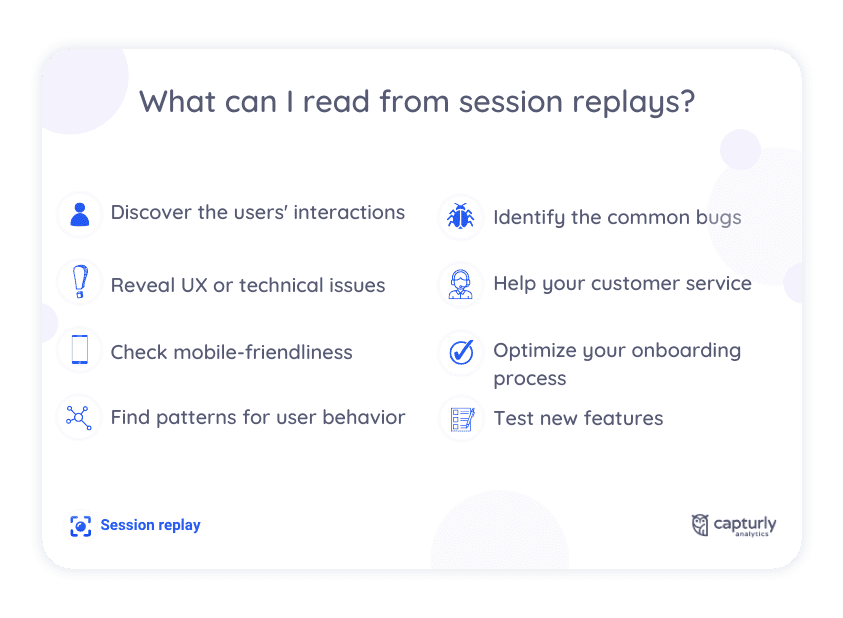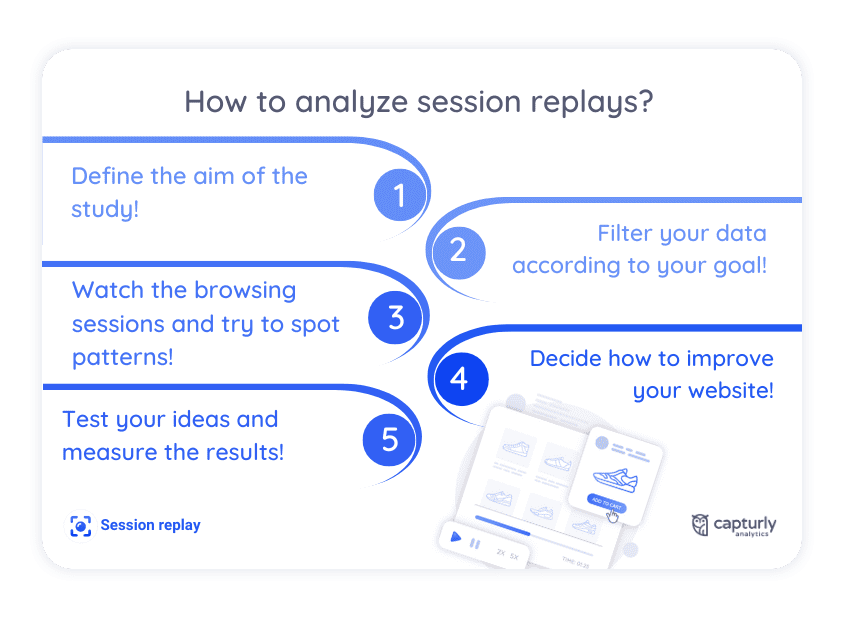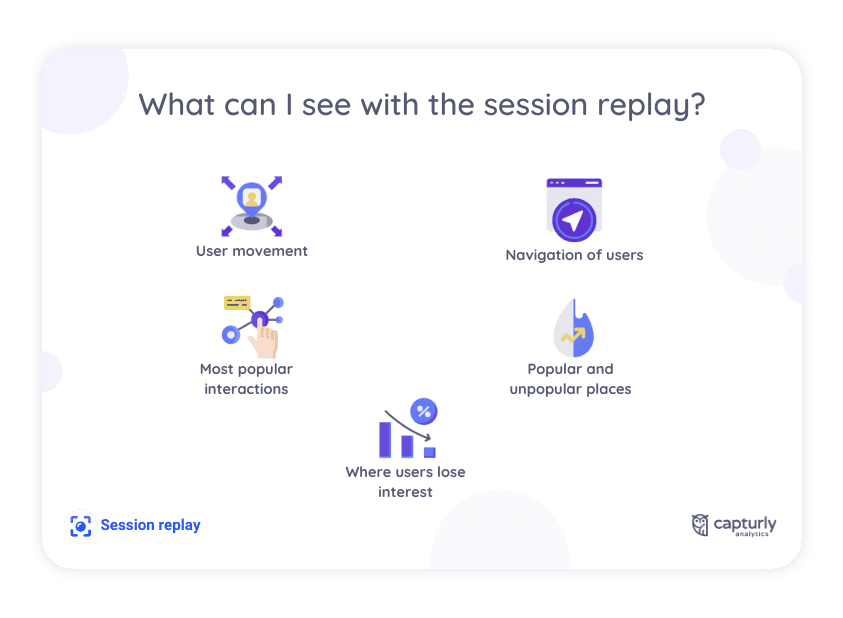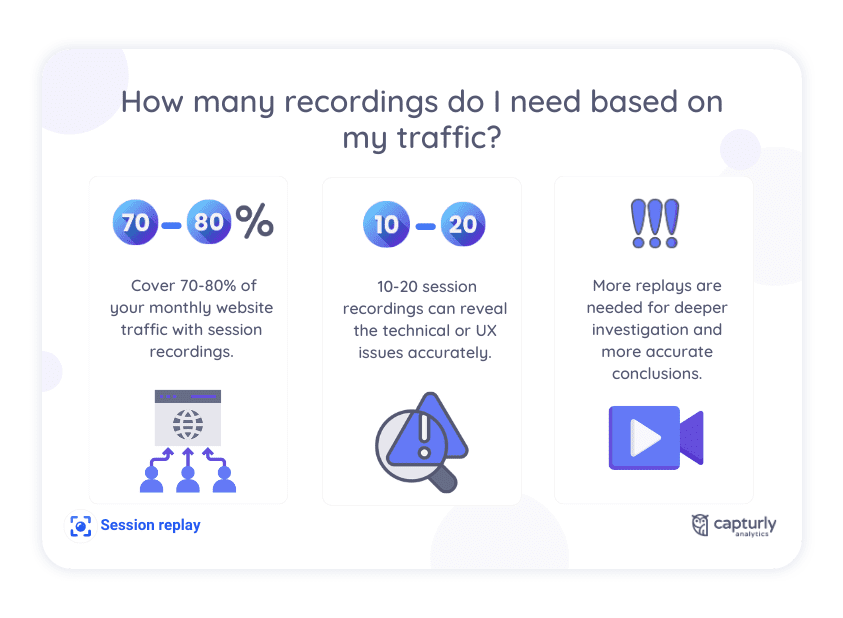In the following, we will guide you through how to effectively analyze session replays to optimize your conversion rate.
What do session recordings tell me?
Session recordings tell you the strengths and weaknesses of your website from the perspective of user-friendliness. For example, session replays show how far users scroll, where they spend the most time, what they skip, where they hesitate, and which items they interact with. Basically, session recordings are used for identifying and fixing user experience issues. It helps to create a website that provides a unique experience for the users. Recordings help you to put yourself into the users’ shoes and go through their browsing experience. Just a few recordings can uncover issues that you may never have been thinking about.
What can I read from session recordings?
Session recordings give you valuable insights into the following areas:

- User interactions with key elements:
Uncover user interactions with crucial elements, such as calls to action or new website features. Session replays reveal how much time users spend on certain pages or spots on the website. If these key elements don’t engage users as expected, consider rearranging your website according to the results of the session recordings. - UX issues that bother users:
For example, some design elements might look stunning, but they completely distract users from key content or functionalities. Some colors or fonts can make it hard to read the texts. It’s also disturbing if an image doesn’t fit into the screen size. After running a session replay, you can easily correct these mistakes. - Mobile-friendliness:
These days people are more likely to browse on mobile devices that don’t have the same screen size as computers. That’s why pages might look different on different devices. Capturly session recordings are also optimized for multiple screen sizes. Hence, they show whether all the items are visible and readable on different devices. - User behavior patterns:
Filter the users based on certain characteristics like new or returning visitors, visitors who bounced, or visitors from the same referrer site. So, try to find behavior patterns. There can be some groups of users that usually follow the same events. In this case, you can easily find your target group. Analyzing visitors that bounce helps you to recreate your website to prevent visitors from leaving it. - Common bugs and technical issues:
Bugs may confuse the users which leads to a poor user experience on the website. It can lead to a higher bounce rate and a lower conversion rate. Reveal the bugs with the help of the session replay tool and fix them as soon as possible. As the number of bugs starts getting lower, the conversion rate starts getting higher.
Did you know? Capturly also features a user frustration detector that identifies rage clicks, JavaScript errors, and U-turns, which further helps you pinpoint problem areas on your website.
All in all, session recordings help you to create the design of your website according to the users’ needs. Put the key information and the call to action on the certain spots that attract the most interactions, in addition to organizing the elements in a way that boosts the user experience the most.
How to analyze session recordings?
While analyzing session replays, follow these steps.

STEP 1 Define the aim of the study
Set questions you’d like to answer to during the analysis. The most common questions are in connection with leaving the website, a few clicks on an item, the performance of a new feature, or design elements.
For instance, if you’ve just recently redesigned your shopping cart page, your analysis could focus on verifying that all functions work properly with the new design.
STEP 2 Filter your data according to the goal you set
It’s easier to cope with narrowed data. Not to mention that it’s easier to focus on a specific target group in this way.
Choose a relevant time period for your analysis, depending on your objectives and the trends you want to investigate.
For example, if you want to investigate a decrease in newly registered users, set filters to display only recordings of the onboarding pages and select a time period when the decrease was observed.
STEP 3 Spot patterns in user behavior
Some events are only triggered by a group of users. By identifying behavior patterns, it’s easier to find solutions that correspond to the users’ needs and preferences.
As an example, if the users look for customer support facilities at the same point during their browsing process, there might be something that’s not clear to them. If a larger group of users face the same issue, consider reevaluating that part of your website to address any confusion.
STEP 4 Decide what to improve or change first on your website
Implement the changes step by step and analyze their impact on user experience.
Focus on addressing the issues that affect the majority of users or occur most frequently during browsing sessions, as these may have the most significant impact on overall user satisfaction.
STEP 5 Test your ideas and measure the results
Continuously evaluate visitor feedback and make necessary adjustments to optimize the user experience. Use data-driven insights to inform your decisions and improve your website’s performance over time.
Tip: Session recordings are also a good way of testing the recently added functions on the website. With this method, you can see whether users find the spot that contains the new features and whether they can use them properly. Follow the steps above and enjoy the high conversion rate!
What can I see with the session replay?
Session replay shows you the movements of a user while browsing on a website, such as clicks, scrolls, mouse movements, and keyboard strokes.
Capturly also detects frustration events, such as rage clicks, mouse outs, u-turns, or occurrences of JavaScript errors.
- Identify popular and unpopular interactions on your website to optimize content and layout.
- Understand user navigation patterns to improve site structure and flow.
- Determine why users are leaving your website and address potential issues. Find the items that disturb the users’ browsing session and try to rearrange them.
- Identify confusing or unreadable elements on various screen sizes and adjust them accordingly. Some items might be confusing for users, or they are simply not readable on certain screen sizes.
- Analyze user scrolling behavior to optimize page length and content placement. There might be a certain spot where users lose interest and quit scrolling.
- Assess overall user-friendliness and identify areas for improvement to enhance the user experience.
In general, examine whether your website is user-friendly enough or if there is anything to improve.

When should I use session replay analysis?
Session replay analysis reveals UX and technical issues which can lead to low conversion rate. In the business world, there’s no conversion rate that can’t be improved, so it’s always a good idea to track and analyze user behavior.
Although session recordings are especially recommended in certain situations, such as when redesigning a website or after making changes to it, before creating a new design, it’s good to know what the popular and unpopular spots are on a website and which parts grab the attention of the users. After the change is implemented, with session recordings you can make sure that it doesn’t bother the users while browsing. Session replays can reveal issues that you might not notice during the development stage.
Please keep in mind that it is useful to monitor the behavior of the users without any changes on the website. Their preferences and habits might change from time to time, and you have to adapt to them to make the website user-friendly.
Is there any free session replay tool?
Capturly offers a free session recording facility in the Free plan. Check it out: https://capturly.com/pricing.
See your visitors’ activity on your website with our free session recording software. Discover rage clicks, u-turns, and JavaScript errors.
How many recordings do I need based on my traffic?
To ensure accurate results, it’s recommended to cover 70-80% of your monthly website traffic with session recordings. These recordings are distributed on every page of your website.
For identifying technical or UX issues, 10-20 session recordings can be sufficient. However, to fully investigate these issues, you’ll need a larger amount of data. Investigating these kinds of issues is only possible when you have an adequate amount of data. Yes, these are not big numbers, but let’s think about it! In case of bugs or errors on a page, it’s a common problem that not every user experiences them. It’s recommended to watch multiple recordings of the browsing history of different users since in this way you can identify some browsing patterns. One recording usually doesn’t seem to be enough.
There might be some features that are not clear to the majority of users, but accidentally one of them manages to fulfill the task. The more recordings you watch, the more precisely you’ll detect the common problems. Prioritize the items and functions that need to be corrected based on the number of users that bumped into an issue with them.
Remember, the more recordings you watch, the more accurately you can detect common problems. Even after solving an issue, continue to make session recordings to ensure your website is always user-friendly.
